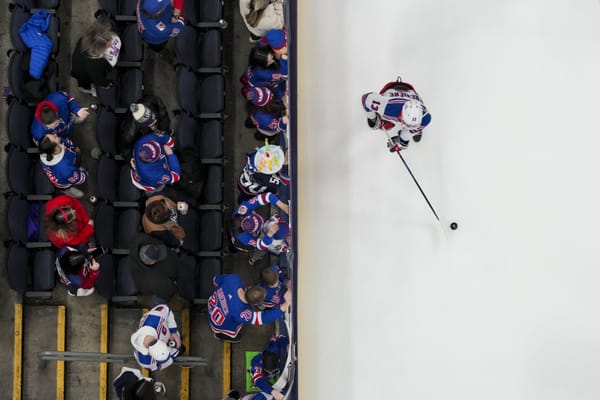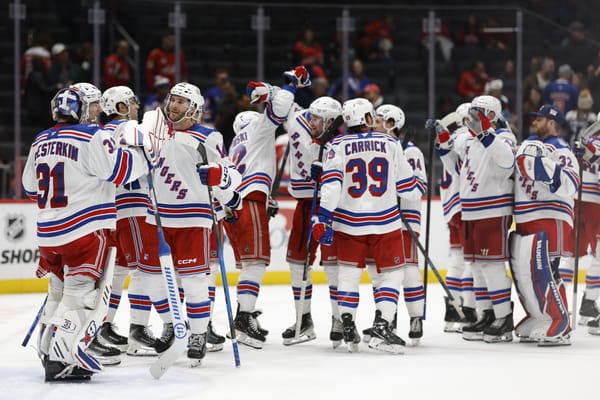What to Make of Artemiy Panarin’s Early-Season Struggles
Artemiy Panarin is off to a slow start by his lofty standards, but Rangers fans should expect a turnaround.
As far as the win-loss columns are concerned, the New York Rangers are off to a solid 4-2-1 start to the regular season. Peeling back the layers of the onion, however, reveals a team that is getting by without much offensive punch, thanks to elite goaltending and some luck.
One player whose game has been a bit off since the start of the season, which is influencing that lack of offensive punch, is superstar Artemiy Panarin. While the Rangers need Panarin to play better, as he’s done in his first two years on Broadway, the fact that he hasn’t yet reached that level this season represents a bit of a silver lining for the Blueshirts. Only a player as good as Panarin could have seven of his worst games over the past two-plus years, and still be producing to a reasonable degree.
Panarin Has Not Quite Been Himself
First, let’s look at the evidence of the Breadman’s early-season struggles. The eye test is telling most of us (at least me) that he is not quite right. Normally an elite passer with exceptional vision and anticipation, Panarin has had a number of glaring turnovers where it seems he’s been trying to force passes or do a bit too much. Some of those have burned the Rangers directly via a goal against.
Get a turnover, wire it home. 💁♂️
— Sportsnet (@Sportsnet) October 23, 2021
Josh Norris extends the @Senators lead to 2. pic.twitter.com/V9JSSVr3O8
Miro Heiskanen? More like Hero Heiskanen!
— SB Nation NHL (@SBNationNHL) October 15, 2021
(because he was the overtime hero, get it?) pic.twitter.com/HSjfM75mAy
In this case, the numbers largely support the eye test. That being said, the small sample size of seven games must be taken into consideration when looking at any of these stats, but early-season trends have nonetheless begun to emerge.
With respect to standard counting stats, four points in seven games is a pretty decent total for the average player, but it’s not where someone like Panarin — who has been better than a point-per-game player in each of the previous three seasons — expects to be. Of course, as mentioned at the top, the fact that he’s not playing well and is still finding a way to hit the score sheet even to this level is the sign of a true superstar. Superstars find a way to produce.
Diving a little deeper, Panarin’s on-ice impacts add some context to the video examples above. So far this season, the Rangers’ expected goal rate for (xGF/60) with the Breadman on the ice at 5-on-5 play is 2.78 per 60, which represents a jump up from the league average. The issue, though, is with Panarin’s defensive impacts. Again at 5-on-5, the Rangers’ expected goals rate against (xGA/60) with Panarin on the ice is 2.92 per 60 — not only a 13-percent spike from the league average, but also a number that exceeds the expected goal generation. This has never been the case during Panarin’s tenure on Broadway; the Rangers’ 5-on-5 xGF/60 has always exceeded their five-on-five xGA/60 during Panarin’s minutes, according to HockeyViz.com.
Below are some heat maps, courtesy of Hockey Viz, that illustrate these statistics with context around where and to what degree excess shots are occurring, with some comparisons to previous seasons further down. Red indicates a higher volume of shots from the given area. Here is how the Rangers look both offensively and defensively with Panarin on the ice this season:
The Rangers are still generating above-average offense with Panarin on the ice, especially from the right side of the slot, but they just have not finished consistently (their team shooting percentage at 5-on-5 ranks 26th in the league). The more glaring problem for Panarin so far this season, again, has been his defensive impact. The Rangers are more often on their heels when he’s out there, yielding high quantities of shots from the high slot.
This is new for Panarin; last season, his offensive impact was actually slightly lower despite his 58 points in 42 games. He did some damage on the power play (18 of his 58 points, or 31 percent, came with the man-advantage; only 25 percent of his points came on the power play in 2019-20), which boosted his overall point totals. But the more drastic difference when compared to the young 2021-22 season was that defensively, he did not hurt the Rangers overall:
Going further back, during his Hart Trophy-finalist campaign of 2019-20, Panarin’s impact on the offense was truly elite. He helped tilt the ice in the Rangers’ favor, to the tune of a 2.94 xGF/60 mark, while being a catalyst for numerous high-quality shots from the prime scoring areas near the net. Meanwhile, the Rangers’ 5-on-5 expected goal rate against with Panarin was 2.58, so not all that close to the excess chances he helped create offensively. His overall impact on shot volume at 5-on-5 coincided with him leading the league in 5-on-5 points that season (and in even-strength scoring overall).
Panarin Should Be Primed to Bounce Back Soon
Panarin averaged 3.28 points per 60 minutes of 5-on-5 play in 2019-20. That number came down slightly to 3.04 last season, and currently sits at a meager 0.58 this season. This is not a sustainable number, so it will bounce back before long. So too will the Rangers’ power play, and the Breadman’s impact on it. The team’s current xGF/60 with Panarin on the power play is 7.72 — down from 9.91 last season and 8.02 the previous season.
When discussing Panarin’s counting stats, on-ice impacts at both even-strength and on the power play, and the Rangers’ team shooting percentage, regression to the mean should occur naturally. He is still creating a positive impact offensively, but just needs to cut down on the turnovers so he is less of a defensive liability. That should be expected, as his defensive impact this season is a glaring outlier from what it’s been historically. The offensive numbers will eventually fall into place as well.
Panarin is about to turn 30, which is often considered “old” in NHL circles. (Isn’t that sad?). But he’s a “young” 30 given that he joined the NHL only six years ago. He was in the KHL — a league with a bigger rink (at least at the time) and generally less physicality — before that, never playing more than 54 games in a season. Plus, he didn’t hit (or get hit) much at the NHL level either over the last few years. So let’s dispel any notions that he’s declining because of age or excess mileage.
His underwhelming early returns this season are difficult to attribute to any one issue, but the absence of his consistent line-mate, Ryan Strome, for four games probably required some type of adjustment. There is also the possibility of early-season rust, as well as becoming accustomed to new head coach Gerard Gallant’s system.
As a whole, the Rangers are also not generating much offense, which puts more pressure on their best offensive player, Panarin, to produce. Once Panarin and the Rangers settle into the season a bit more, both the numbers and the electrifying player we’ve seen on the ice in years past will return to form.





